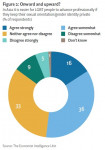In the Internet age, physical location remains a key driver of innovation, says Economist Intelligence Unit
Key findings include:
· The most innovative locations are those with the healthiest supplies of talent. Ninety percent of executives surveyed consider access to skilled people to be critical for innovation. Nurturing talent requires top-notch education, which in turn plays a role in the tendency for likeminded organisations to “cluster”, or locate near each other. Organisations are willing to pay a premium for access to talent, and proximity to a cluster contributes to their ability to innovate.
· Policymakers can help to stimulate innovation in cities and regions, but they must take a long-term perspective. Legal, regulatory and financial measures have been widely used to create a more fertile environment for innovation, but some regions have been more successful than others in reaching this goal. In part, this is a cultural issue: respondents rank business culture (such as a tolerance of risk) an important factor contributing to their ability to innovate, second only to access to skills. The local climate for venture capital is also deemed very important. Building these stimulating qualities can take decades.
· Organisations are increasingly sourcing their innovations globally and externally. As large organisations have disaggregated and globalised, they have realised that they need to go far afield for innovation. A particularly creative process is “open innovation”, where intellectual property flows in and out of organisations to where it can be most useful in developing new products and services. Fifty-four per cent of survey respondents say that, through 2013, most of their innovative capacity will be provided by open innovation and by Internet-enabled techniques.
· While virtual collaboration is growing, face-to-face interaction is also becoming more important. In spite of major advances in networked information technology, innovation still requires face-to-face contact to be successful, especially in the early stages. Brainstorming is the most popular innovation technique, according to survey respondents, while interviewees emphasise the value of physical contact to build trust between potential collaborators. Nevertheless, the Internet is already vital in one area of innovation – that of “co-creation”, the practice of involving customers in the development of new products and services through feedback and suggestions. Sixty per cent of survey respondents say they are co-creating with customers on-line.
· US still attracts investments in innovation, but China and India gain ground. Asked where they are making the biggest investment to boost their capacity to innovate, survey respondents rank the US their number-one destination. India, China and the UK form a second tier, followed by Canada, Australia and Brazil.
“Successful innovation requires a judicious blend of the local and the global. There really is no substitute for meeting in person if an idea is to germinate into a commercial success,” says Katherine Dorr Abreu, the editor of the report.
Fertile ground: cultivating a talent for innovation is available free of charge at: www.eiu.com/sponsor/ontariocanada/innovation
Notes for editors
Fertile Ground: cultivating a talent for innovation is an Economist Intelligence Unit report, in co-operation with Ontario, Canada. The research is based on an online survey of 200 senior executives from around the world conducted by the Economist Intelligence Unit in September 2008. Thirty-two percent of respondents work for companies headquartered in North America, 32% in Europe, 27% in the Asia-Pacific region, and 10% from the rest of the world. Fifty percent of respondents were C-level executives. They have a broad range of roles, with 41% responsible for strategy and business development, 39% for general management, and 26% for marketing and sales. Fifty-four percent of the respondents’ organisations had annual revenues of more than US$500m. Respondents represent a broad range of industries. The quantitative survey was supplemented with interviews with executives and experts worldwide who addressed innovation and the importance of talent and location.
About the Economist Intelligence Unit
The Economist Intelligence Unit is the world leader in global business intelligence. It is the business–to–business arm of The Economist Group, which publishes The Economist newspaper. As the world's leading provider of country intelligence, the Economist Intelligence Unit helps executives make better business decisions by providing timely, reliable and impartial analysis on worldwide market trends and business strategies. More information about the Economist Intelligence Unit can be found at www.eiu.com.
About Ontario, Canada
Ontario, Canada is the "economic powerhouse" of Canada making it a premier destination for new investment, and a source of quality products and services with global appeal. To learn more about Ontario's place in today's every-changing global economy, go to www.investinontario.com
# # #
웹사이트: http://www.eiu.com
연락처
Joanne McKenna, Press Liaison, +44 (0)20 7576 8188; 이메일 보내기
이 보도자료는 Economist Intelligence Unit가(이) 작성해 뉴스와이어 서비스를 통해 배포한 뉴스입니다.




